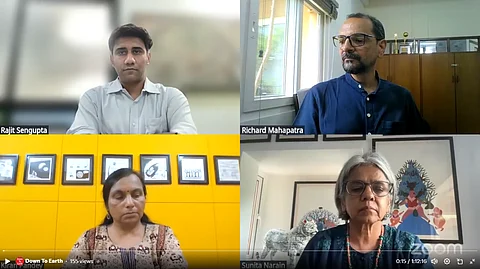

As the world prepares to observe Environment Day on June 5, the Centre for Science and Environment (CSE) has sounded a sobering alarm: India is facing a mounting crisis on multiple environmental and development fronts. The Delhi-based think tank’s annual State of India’s Environment in Figures 2025 report, released in the capital on June 4, 2025 offered a stark data-led portrait of a nation grappling with extreme weather, declining public health, stalled infrastructure and deepening economic strain.
Using 48 indicators across four thematic areas, environment, agriculture, public health and human development, the report ranked all 36 states and Union Territories.
While Andhra Pradesh, Sikkim and Goa top the charts in individual categories, the broader picture is bleak. No state emerges as a consistent performer across all domains and even top-ranked states struggle with fundamental issues such as pollution, waste management and access to health care.
“Numbers usually give us the truth and what we are unveiling on the eve of this year’s World Environment Day based on data that the government itself has generated and which is available publicly, clearly indicates that this is not the time for complacency, nor for chest-thumping,” said Sunita Narain, CSE’s director general, at the launch.
Andhra Pradesh led in environmental management, thanks to its forest and biodiversity conservation efforts. Yet it fared poorly in sewage treatment and river pollution control. Sikkim’s organic farming and sustainable land-use practices helped it top the agriculture rankings, but it lagged in farmer welfare.
Goa is the best in public health and infrastructure, with the country’s highest rate of medically certified deaths. Still, it faced a shortage of hospital beds and low female labour force participation.
Large, populous states — including Uttar Pradesh, Maharashtra, Bihar and West Bengal, home to nearly half of India’s population — ranked poorly across all categories, leaving vast swathes of the population vulnerable to climate and health shocks.
“Though data gaps remain a major concern, the report is important because it joins the dots and interprets whatever data is available and existing to make a factual statement on environment and development.,” said Richard Mahapatra, managing editor of Down To Earth (DTE), which co-published the report with CSE.
The data made it clear that 2024 was a watershed moment. It was India’s warmest year on record, with 25 states experiencing record-breaking rainfall.
“Extreme weather events occurred on 88 per cent of the days in 2024, marking a sharp rise in both frequency and impact since 2022. Natural disasters induced by extreme weather and other reasons emerged as the primary drivers of internal displacement,” Rajit Sengupta, associate editor of DTE and one of the authors of the study .
Extreme weather events triggered 5.4 million internal displacements, nearly half in Assam, marking the highest climate-linked migration since 2013. Floods alone caused two-thirds of the displacement, the report found.
India’s greenhouse gas emissions reached their highest global share — 7.8 per cent — since 1970. More worryingly, the rate of emissions growth has accelerated in recent years, rising by nearly one percentage point between 2020 and 2023 alone, it stated.
The country continued to overdraw its groundwater reserves, with 135 districts now extracting water from depths exceeding 40 metres — nearly double the number in 2014. Toxic heavy metals were found in almost half of the country’s monitored river sites in 2022. Despite its 2026 deadline, the government has remediated only half of its legacy waste, the report said.
Waste of all kinds is soaring. E-waste rose by 147 per cent in just seven years. Plastic waste, despite a partial ban, hit a record 4.14 million tonnes in 2022-23. Forest diversions for development reached a decade-high last year, with 29,000 hectares cleared, mostly in states like Jharkhand and Uttar Pradesh, the report stated.
These diversions, which disrupt wildlife corridors, are one of the causes of the country's rising human-animal conflict rates, said Kiran Pandey, programme director at CSE. “In 2023-24, human deaths due to elephant attacks rose by 36 per cent compared to 2020-23. Tiger attacks caused 82 human deaths during this period, marking the second highest toll since 2020,” she said at the launch of the report.
Air pollution continues to extract a deadly toll. Since 2021, residents in 13 Indian capitals, including Delhi, have breathed unsafe air one in every three days. Life expectancy in Delhi is nearly eight years shorter due to air pollution. In Lucknow, it is over six years.
The pandemic’s legacy also looms large, the paper found. India saw 3.06 million excess deaths in 2020-21, six times the official COVID toll. Meanwhile, overburdened public health systems persist: India needs 36 per cent more community health centres and faces an 80 per cent shortfall in specialists. Out-of-pocket spending rose to over 45 per cent of total health expenditure, outpacing government health spending in many states.
In Uttar Pradesh, nearly two-thirds of all health expenses were borne by individuals. Kerala and West Bengal also recorded alarmingly high levels of private spending.
Economic precarity is deepening, the report revealed. Adjusted for inflation, incomes for salaried and self-employed workers declined between 2017 and 2023. Over 73 per cent of India’s workforce is informal and more than half of regular workers lack basic protections like paid leave or contracts.
Gender gaps remain stark: while over 60 per cent of men are employed full-time, only one in five women are and they work fewer hours.
“The report does not discount the enormous strides that India has made in many fields,” Narain said in her closing remarks. “What it essentially does is hold up a mirror and make us acquainted with the fact that we need to sit back and take note of the trends, make sense of them and initiate corrective actions.”
She called on the government to invest more in data collection and transparency. “Unless we have clear, credible data, there can be no solutions or policies. Our strong plea therefore is that we need more — not less — data.”